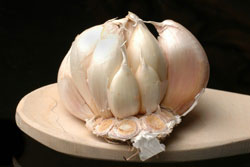The Many Health Benefits of Garlic
Various records exist today that document the use of garlic as medicine throughout history. So many cultures are
steeped in folklore and old wives’ tales about the plant and its properties. There are, in fact, few ailments for which
garlic has not been prescribed at one time or another. Because it is easy to cultivate and grows prolifically, garlic has
also retained an image as the miracle cure that even the poor can afford.
Ancient Roman physicians used it as an antiseptic dressing for wounds. The Indian system of medicine known as
Ayurveda still recognizes its effectiveness against digestive disorders.  The Egyptian Book of the Dead contains
references to 22 garlic remedies; and the plant has always found favor in Oriental medicine as well.
The Egyptian Book of the Dead contains
references to 22 garlic remedies; and the plant has always found favor in Oriental medicine as well.
Diuretic, laxative, cough suppressant, giver of strength and disease preventative: garlic has been employed for all of
these uses and more. But do the healing powers ascribed to it by old, natural traditions of medicine have any real basis in
fact? Actually, though some aspects of the action of garlic and what it can cure remain unclear, modern science has
confirmed many of the benefits that people have attributed to the plant since ancient times.
The chief source of garlic’s therapeutic power lies in its volatile oil. This oil contains a substance known as
alliin that transforms into allicin when the garlic is crushed or cut. Allicin, in turn becomes diallydisulphide
after it’s exposed to air, and it is this final substance that acts as a strong antibacterial agent. Garlic
actually helps to destroy the kinds of bacteria that attack the body whilst encouraging beneficial bacteria to form
in the digestive tract. Its antiseptic properties are even effective against respiratory infections like coughs
and common colds because the natural oil is excreted through the lungs. In addition, garlic can be applied
topically because the oil can be absorbed through the skin and then carried by blood to the lungs.
In addition to the work of its volatile oils, the alkaline salts and sulfur components within garlic act as blood
purifiers. Its juice can be applied as an antiseptic on wounds. Regular eating of garlic — at least a clove a day — will
aid in the production of healthy white blood cells that fight infections, contribute to good digestion and the maintenance
of optimum blood pressure, help rid the body of parasites, and act overall as a good disease preventative.
Unfortunately, roasting, grilling and steaming garlic will alter its chemical composition and squander many of
these beneficial attributes. Many countries now have garlic capsules available that are filled with oil extracted,
by steam, from crushed bulbs. There is some debate concerning the strength of this form as opposed to raw garlic.
Another option is simply to blend a clove in with other foods — for example, crush it and mix it into salad
dressing. The purer the form of garlic that you can bear to take, the more health benefits you will reap from it.
|